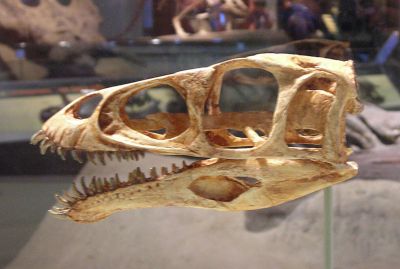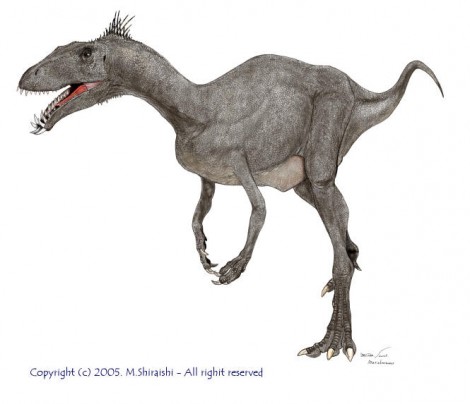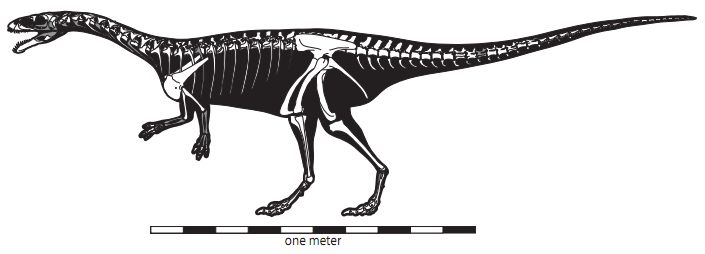
Skull of Masiakosaurus at the Field Museum of Chicago
Photo by DinoGuy2, Wikipedia, /Creative Commons Attribution Share Alike
| Theropoda | ||
| The Vertebrates | Noasauridae |
| Vertebrates Home | Vertebrate | Vertebrate |
|
Abbreviated Dendrogram
Dinosauria
├─Ornithischia
└─┬─Sauropodomorpha
│
└─Theropoda
├─Herrerasauridae
└─┬─Podokesauridae
└─┬─Dilophosaurus
├─Ceratosauria
│ ├─"Limusauridae"
│ └─┬─Ceratosaurus
│ └─Abelisauroidea
│ ├─Noasauridae
│ │ ├─Laevisuchus
│ │ ├─Masiakasaurus
│ │ ├─Noasaurus
│ │ └─Velocisaurus
│ └─Abelisauridae
└─Tetanurae
└─Avetheropoda
├─Carnosauria
╘═Coelurosauria
└─Aves
|
Contents
Index |

The Noasaurs were the Coelurosaurs of the south. These highly successful animals ranged across Gondwana, and even reached Europe. They are actually derived ceratosaurs, and although cladistically they always appear as the sisiter taxon to the Abelisauridae (given the current data sets), morphologically they are intermediate between more primitive forms such as Ceratosaurus and Elaphrosaurus, and the Abelisaurids proper. It is quite likely that with further discoveries and better material the group may turn out to be a paraphyletic or evolutionary grade. They include both small animals such as Velocisaurus of South America, and medium sized (1.5 to 32m) long Noasaurus of Late Cretaceous South America and Masiakasaurus of Late Cretaceous Madagascar. Perhaps because of the scrappy material of most taxa (apart from Masiakasaurus), phylogenetic relationships are uncertain. MAK120208
 Skull of Masiakosaurus at the Field Museum of Chicago Photo by DinoGuy2, Wikipedia, /Creative Commons Attribution Share Alike |
Noasauridae Bonaparte & Powell, 1980 : Noasaurus, Masiakasaurus
Phylogenetic definition: The most inclusive clade containing Noasaurus leali Bonaparte and Powell 1980 but not Carnotaurus sastrei Bonaparte 1985, Coelophysis bauri (Cope 1889), or Passer domesticus (Linnaeus 1758). (stem-based) (Paul Sereno - Taxon Search)
Range: Middle to Late Cretaceous (Albian to Maastrichtian) of Europe (France), South America (Argentina), India, Madagascar, and Africa (Niger). (Carrano et al 2011)
Phylogeny: Abelisauroidea : Abelisauridae + * : Laevisuchus + Masiakasaurus + Noasaurus + Velocisaurus
Characters: metatarsal IV distal end reduced (Sereno et al 2004).
Comments: Noasaurids differ from Abelisauridae in retaining plesiomorphic long forelimbs with well developed claws, as occurs plesiomorphically in most basal theropods (e.g., Coelophysis). (Agnolin & Chiarelli 2010). the noasaurid skull was not especially modified relative to those of other ceratosaurs except with regard to the anterior portions of the jaws. In some external element sculpturing and lacrimal morphology, they exhibit an intermediate condition between more basal ceratosaurs and abelisaurids. Ddiffers from abelisaurids in feeding specializations, as well as body-size reduction, but the many derived characters shared between noasaurids and abelisaurids indicate a great deal of functional similarity in the lower jaw, axial column, shoulder girdle, and hind limb between these groups. Carrano et al 2011 (MAK120211)
Noasaurus leali Bonaparte and Powell, 1980
Horizon: Lecho Formation, El Brete, Salta, Argentina (early Maastrichtian)
Phylogeny: Noasauridae ::: *
Characters: maxillary tooth count reduced to no more than 10; cervical neural arch with anterior epipophyseal prong (Bonaparte & Powell, 1980)
Comments: known from skull elements, vertebrae, pedal (foot) elements, and a large claw, it was originally thought that Noasaurus was a Gondwanan equivalent of the sickle-clawed maniraptors of the northern continents, perhaps by analogy with the parallel sabre toothed cats and the South American sabre-toothed marsupials that lived during the same time but in isolation. But restudy of the dissarticulated non-ungueal phalanges of the Argentinean Noasaurus leali and Ligabueino andesi revealed that the supposed raptorial claw of the second pedal digit of N. leali actually belongs to the first or second finger of the manus (hand), and the non-ungual phalanges previously attributed to the feet of both genera also pertain to the hand. This also blurs the distinctions between Noasauridae and Velocisauridae. (Agnolin & Chiarelli 2010) MAK120211
 Composite skeletal reconstruction of Masiakasaurus knopfleri in left lateral view, showing recovered (white) and missing (gray) elements. Illustration and caption from Carrano et al 2011 fig.1 |
Masiakasaurus knopfleri Sampson et al., 2001
Horizon: Maevarano Formation of northwestern Madagascar. (Middle Maastrichtian)
Phylogeny: Noasauridae ::: *
Size: about 2 meters long
Comments: By far the most completely known noasaurid, Masiakasaurus was first described from disassociated elements representing nearly 40% of the skeleton, and now known from abundant new materials that help further resolve its phylogenetic status, including most of the skull and about 65% of the skeletal elements, permitting a much more accurate reconstruction, and greater insight into the specializations of noasaurids in general. Carrano et al 2011. AUnfortunately the incompleteness of other noasaurid taxa means there are few opportunities for detailed comparisons.
Masiakasaurus was highly unusual by its forward-jutting teeth, indicating a specialized diet, probably piscivous. The forelimbs, although much shorter than the hindlimbs, were not vestigal in the way they are in abelisaurids. The type species, Masiakasaurus knopfleri, was named after the musician Mark Knopfler, the guitarist and singer/songwriter of the band Dire Straits, whose music inspired expedition crews.
Laevisuchus indicus Huene and Matley, 1933
Horizon: Lower Lameta Group, Madhya Pradesh, India Age: mid-late Maastrichtian
Phylogeny: Noasauridae ::: *
Length: estimated about 2 meters
Comments: known only from a few vertebrae, this theropod has previously been considered a coelurid, but has more recently been shown to probably be a small abelisaurian. Th vertebrae share some synapomorphies with Masiakasaurus and Noasaurus, so all three can be placed in the Noasauridae (Carrano et al. 2002; Carrano & Sampson 2008). This is only one of a large number of small, poorly known forms are known from the Lameta Beds (Coeluroides, Compsosuchus, Dryptosauroides, Jubbulpuria, Laevisuchus, Lametasaurus, and Ornithomimoides). Whilst most likely Ceratosaurian, their relation to the abelisaurids is not clear, although at least some if not all are probably synonyms, and belong to the Noasauridae (Carrano & Sampson 2008, Carrano et al 2011) MAK120211
Velocisaurus unicus Bonaparte, 1991
Horizon: Neuquen, Argentina (Coniacian/Santonian)
Phylogeny: Noasauridae ::: *
Length: estimated about 1.2 meters
Comments: known only from a partial hindlimb, this was a small swift-running animal. Originally placed in its own family, Velocisauridae, it now appears to be a Noasaurid. The middle metatarsal bone in the foot is greatly enlargened, while the outer ones were reduced. the reduction of metatarsal II, the same as with Masiakasaurus and Noasaurus. Although probably an adaptation for running, it is the opposite to that of many running coelurosaurs (whose outer metatarsals became stronger, greatly reducing the inner one). The toe proportions suggest it fed like a chicken, through scratching at the ground. MAK990512 120211
page MAK120219